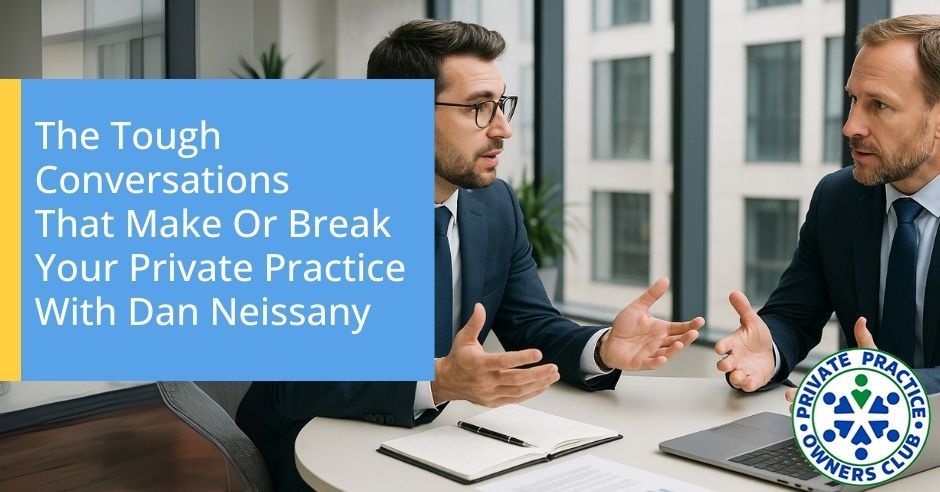In this episode of the Private Practice Owners Club podcast, Nathan Shields sits down with
Lance Gross of
GTS Physical Therapy to tackle one of the most overlooked profit killers in private practice: poor revenue cycle management (RCM), leading to sub-optimal revenue and profits.
Lance breaks down how clinic owners can dramatically improve cash flow, revenue, and profitability by tightening up RCM systems—without seeing more patients or working more hours. From monitoring provider billing habits to boosting patient retention and increasing frequency of care, we explore the small tweaks that lead to big financial wins.
If your clinic is bringing in patients but profits aren't where they should be, this conversation will show you exactly where to look and what to change.
Whether you're in growth mode or just trying to stop the bleeding, this episode gives you the tools to take control of your financial future—starting today.
To hear more from Lance and how he grew to 25 clinics in 7 years, join us at the PPOClub Conference in Destin, FL, Oct. 2-4, 2025. Register here - https://ppoclubevents.com/homepage
---
Listen to the Podcast here
Getting Paid What You're Worth: Revenue Tips For Private Practices With Lance Gross
Welcome to the Private Practice Owners Club. I am Nathan Shields. I've got another speaker for our Private Practice Owners Club conference coming up on October 2 through 4, 2025, in Destin, Florida,
Lance Gross. Lance, I'm excited to have you on. I appreciate it.
Thanks, Nathan. Thanks for having me. I’m looking forward to talking to you and then seeing you in Destin in October.
Lance is the founder and CEO of
GTS Physical Therapy. They currently have 24 clinics and will soon have 25 clinics, all in Arkansas and one in Missouri. All of that growth has happened in the past seven years. It is a wild ride and a lot of growth in a short period of time. It is hard to imagine. That's why I reached out to him to pick his brain and ask him to present at the conference in October. I'm excited to also highlight him because we're going to talk about his success in revenue cycle management.
You might have heard RCM as an acronym for that. It all has to do with billing, collections, and the financial side of the operations in the organization. Lance had some great success in a lot of the financial KPIs, the billing, and coding KPIs that I've stressed in the past. I'm excited to talk to him because he's got real-world experience with real-world dollars behind it. I can show the success if we focus on some of these things. Lance, I'm assuming that as you have grown these clinics, you have to focus on the financials, but sometimes they can get lost. I'm assuming there can be distractions. Maybe you're focusing on other things, but there's no tight control on the financials on a regular basis. Would you say that? Is it hard?
That's 100% right. There are so many things you have to monitor with financials. If you've got multiple clinics or even one clinic, you've got to monitor the electric bill, the phone bill, and those things. It's easy to get lost with billing and coding because we assume that all of our great team members are doing the billing and coding like they're supposed to do. You assume this is a doctor of PT. He has twelve years of experience. This is a PTA with fourteen years of experience.
You assume they're doing their billing and coding properly, like they're supposed to do it, and everything is hunky-dory. That's what you assume. From my experience as an owner, I was more concerned about looking at arrival rates, cancellation rates, and scheduling rates. What's our plan of care? Are we doing twice a week or four weeks? Are we trying to get them three times a week for six weeks, or getting that? Getting more patients in the building is more of what I was concerned about.
Uncovering Hidden Revenue: The Billing And Coding Audit
In the fall of 2023, I was doing a profit leak audit tool thing. I was looking at those metrics. I got looking into it and probably spent an hour, maybe less than an hour. I started looking at some billing trends. I'm like, “Wait a second. This patient was in the building for 62 minutes, and we built three units. Patient C was in the building for 41 minutes. We built two units. This patient was an AMA payer, and we built two units for an hour treatment.” That's an extreme.
How pervasive was that? Were you talking 30% of your documents, 50%, or higher?
Normally, I keep exact numbers, but this is definitely in the 40% range.
It wasn't one out of ten or two out of ten years doing this over and over again.
It was overwhelming. I was like, “I've got to stop looking at the visit counts now and look at this as more important. This is way more important than what I'm doing.”
These people are already in the clinic. You don't have to pay for another piece of equipment. You don't need to get them in again. You don't need more new patients. These are underbilled services.
Our therapists were doing 60 minutes of work. We're getting paid for 45 minutes of it. They were shortchanging themselves and the whole company. A lot of that I found out after talking to them. A lot of them didn't understand the billing rules for either AMA payer rules, the eight-minute rule, or the CMS eight-minute rule. They didn't understand those two differences and understand how you can treat multiple places at the same time and how to bill those properly.
No one is ever trained in that. Even though they had years of experience, they didn't understand that. I was like, “Okay.” I talked to a few of them. “That's not how you do it. I think you can do it this way,” but I wasn't 100% myself. I spent probably 30 or 40 hours at least researching through Medicare guidelines and AMA payer guidelines. I put together a course for my whole team. I spent all this time anyway, dealing with this course. We met in December of 2023.
I'm curious. Where did you find some of these resources that you felt like you could trust, and they weren't just opinions from some guy on a podcast? Where did you find some of those resources that you could trust and that also your clinicians could say, “That's verifiable. That's an appropriate resource?”
It started with some online searches. I fall back on
Rick Gawenda a lot.
I was going to ask you if Rick was a part of it.
A lot of my stuff came from Rick. I talked to Rick a few times about that thing. A lot of things came from him because he cites Medicare guidelines. You can say this. “Here's what it is. I got the Medicare guidelines.” Anyway, I had Medicare guidelines and AMA guidelines to support the legal stuff, which is hard to read and put into real life what it means. We got together in December 2023. I did a four-hour presentation in front of my whole team, all my clinicians, and trained them on how to do their billing properly.
We went through the whole thing. There's a pre-test to it that I made up. It's like a pre-test. What's your knowledge base of AMA payers and CMS payers? How many patients can you see per hour? How do you bill this? We did case studies. We took several different patient charts, actual real patient records, and looked at them as a group. “Here's this document. Here's what it says in it. What do you see that we could have built in here? What did we bill based on different payer types, based on whether there were two patients in the room?” It is all this stuff. You think, “Hopefully, that went well.” As of four hours up there, part of them are like, “I got this, whatever.”
We went back over the course of the next year. I compared 2023 revenue numbers to 2024 revenue numbers. What happened was our unit total per visit went up 0.56 units per visit, which doesn't sound like a lot, but a little over half a unit per visit compared to 2023. The same number of patients in 2023, let's say whatever it was, 100,000 visits, is the same 100,000 visits in 2024. Our revenue increased $1.4 million in 2024 with the same number of patients as it would have been in 2023. I didn't count the growth we had.
I took the same number we had in 2023. $1.4 million for me, spending 40 hours of my time in a four-hour conversation that is that much driven. Like you said earlier, we didn't see a single extra patient, didn't work a single extra hour, and didn't do a single bit of different documentation. We simply coded what we were doing. We were billing appropriately for what we were doing. It made that much difference. That's a humongous difference across our scale. A smaller practice wouldn't be as big, but still, it's money we're bleeding out there.
Maximizing Value: Ethical Billing For Physical Therapy Services
To look at the larger picture, there's a common theme, like reimbursement rates are declining, and that's verifiable, but there's also a feeling. Sometimes, I hear it amongst the industries that we're not getting paid what we're worth, especially compared to the impact that we have on people's lives. Part of me is like, “You're not placing enough value on your work that you're doing.” If I'm talking to the individual practitioner, if you billed better, you would be getting paid more.
It takes some of this knowledge to fight against the decline in reimbursement, but also to get paid more for the value that we provide. If we believe that we provide a ton of value, we should be billing as much as we possibly can ethically, with the proper documentation to support it for the services that we provide. You can't complain about the rest of it if you're not doing that on a regular basis. There's so much fear in the unethical billing practices or the overbilling practices of people in the past that they unfortunately, and I would even say unethically, underbill for their services.
We talked about this earlier, a little bit. Clinicians, physical therapists, and occupational therapists sometimes feel guilty about billing. We have real guilt about, “They were here 40 minutes. How am I going to charge five units for that?” Because it's an AMA payer, you can charge five units. That's their rules. Follow their rules. They're expecting you to do that. We're not salesmen, as we talked earlier. We feel guilty about doing that or overcharging someone. I hear some of my clinicians and others talk about their fraud. They must be trained that in school these days, like, “Worry about fraud. You're committing fraud if you're overbilling.”
You're going to lose your license and all that stuff.
Part of my talk with my team, our new team members, or whenever I talk to them, is that you're billing for your time. You're not billing for the patient's time. You're billing 100% for your time. If you're there for an hour and there are patients in the building, and it could be one or seven, for an hour, you need to bill for your whole hour time, as effectively as you can. Whatever pay resources you have, bill for that time. You can't bill more than your hour, but you can bill your hour, as long as there are patients in that building and you're supervising or working with them.
It's easy to get lost with billing and coding because we assume our great team members are doing it like they're supposed to.
That's what you have to look at. You can't bill seven years to all of them. You can't do that, but you can bill your maximum amount to that. A simple thing, I ask the question a lot. If you had two patients in the building, one was an AMA payer and one was a Medicare payer, how many units could you bill for that hour? You spent an hour, both of them. They're both there at the same time. How many units would you bill? The answer is seven because you can bill seven eight-minute units. Bill one to the Medicare one, and bill six to the Blue Cross one. You've treated them both the same. Everything's good. They both got an hour of treatment, but your billing is maximized that way.
Another way I look at it and tell them is that most of our AMA payers that pay by that rule give us the number of visits they allow. They're allowing twelve visits or 30 visits a year. You go to authorization. You authorize twelve visits. Once those visits are authorized, they don't care how many units you bill. They expect you to bill the maximum amount that you're billing. If they're there for an hour, they expect you to bill those 7 or 8 units. That's what they expect. That's their loss. They figure that's what they're going to pay out for it. If you're billing less, you're saving the insurance company money. Blue Cross Blue Shield is like, “Thank God they didn't bill seven units when they could have. That's amazing.”
Does your training also go into what higher CPT codes or what CPT codes reimburse more versus others? I don't know how old you are, but I'm old school. It used to be the three and one, three TherEx, one manual. That's all we billed all the time for every hour that we treated. If you were to do that now, that's the lowest possible reimbursement rate you could possibly bill for. All it takes is some justifications on the documentation side and knowing the difference between the CPT codes to justify a greater reimbursement rate.
We talk a lot about code diversity. We try not to bill for two of the same thing. Try your best not to bill two TherExes. Try to bill one of each if you can. You can justify it with your documentation and what you did, and then try to bill for the higher code. If you can bill therapy activities, then go for it. If you can bill neuromuscular therapy instead of that, then go for it. Part of my course is a way I have them ranked. I put all the CPT codes out there.
Rank them in the highest. How do they pay? Which one's the highest payer? Nobody knows. They don't even know. You've got to know that first. We preach that a lot. You understand this pays $12 more than this does. You're doing the same thing. Why not push that button instead of the other button? That makes us $12 more and justified in documentation. That's all you can do.
My example I give for an exercise I do in front when I'm doing my course is I stand on a seated heel raise. What did I do? How are we going to bill that? Is that going to be TherEx? Are they activities? Is it neuromuscular re-ed? Could it be training? It could be all the same. If I resist them on the shoulders, it's manual. You could go five different ways, depending on how you document it. Why are we doing a standing heel raise? That makes them think a little bit and get some going.
Beyond Billing: Key KPIs For Clinic Profitability
We're talking a little bit about coding and what we can bill. What are some other statistics that you found were helpful in maximizing production and profitability in some of these visits, maybe along the lines of visits per week or completed plans of care? What other KPIs have you found to be powerful in optimizing the care?
It is the business per plan of care. Whatever our standard, we do for twelve. Twelve is where we're at.
That's industry standard.
Twelve is where we shoot for. That's what we're shooting at for twelve with that spread out for four weeks, six weeks, or whatever. In my plans of care, I still see patients every day. I treat almost a full caseload. It is two or three times a week for twelve weeks. When I have to ask for authorizations, a lot of the time, they'll give me twelve weeks if I ask for it. I might as well not ask for it up front. Ask for the moon and get it up front.
That way, it's easier the first time than the second time to ask. That's how I wrote my plans out. I try to explain to my patients, “Let's do three times a week for the first few weeks. As you improve, we can drop down to twice a week,” to try to get them in there for the maximum amount of visits. We can try to preach a lot to our clinicians. Patients love to self-discharge. They've come four times in their life. You may feel great. “You've done for me in four visits what nobody has done. I feel amazing. I'm not coming back yet.” You're like, “Wait a minute. In two weeks, you're going to revert to where you were,” which they don't understand.
We try not to educate our patients on that. We use the four-phase rehab if you guys have ever seen that four-phase. We have that posted everywhere. We have posters in our clinics everywhere. Every patient who comes gets a flyer in their goodie bag. This explains a four-phase rehab. Our clinicians are trained. If someone tries to self-discharge, they get the poster out and explain, “Here's where you're at. You're at phase two. We still have to strengthen you and stabilize you and get this going. Your insurance pays for 30 visits. Don't stop now. Let's keep going.” It is trying to get patients not to self-discharge because that's a huge problem. Everybody has that.
You've got enough providers now that there is a tendency, a little bit, to allow compassion and empathy to affect their plans of care. What I mean by that is, and I experienced it as well, “I need to see you for twelve visits.” They're like, “Man, I've got a $40 copay. That's a lot of money.” That's when you might see providers back off and provide a different plan of care based on that financial picture, which isn't appropriate. If we believe that we're doctors of physical therapy, we should stick to our plan of care in spite of the financial concerns.
I use the analogy all the time. If I express the financial concern regarding prescription medication that the doctor gave me, he's not going to say, “Instead of taking two a day, take one a day.” I'm like, “Am I going to get the same benefits?” “No, because I told you to come to take two a day.” It's the same thing with physical therapy. If I think you need to come three times a week, there's no way in God's green earth that I can get you better in one time a week.
That is, if I truly believe that three times a week is medically appropriate. When people bring out their copay concerns, we'll fall back and say, “Maybe two times or maybe one time a week. We'll see what we can do.” Maybe you can do a home exercise program, but how do you get over that with your team members? How do you get them to sell the full plan of care and get them to come in for the full plan of care?
The Importance Of A Strong Front Desk In RCM Success
That's one of our hardest obstacles.
That is a big one.
You laid it out perfectly there. As therapists, we're compassionate humans, most of us. When the patient brings up concerns about finances, we tend to back off or do less plan of care. We try our best. It doesn't happen. If I could say, it does happen. A hundred percent of the time, it doesn't, but across the board, as the clinician does, like you said, “This is going to take twice a week for eight weeks to get you where I need you to be. For any financial talk, you can have that with the front desk.” Let them handle that at the front desk.
We do some things to get financial arrangements and things, weekly payment, all that stuff. Let the front desk handle that. Take it off the clinician. We'll try to get them to stop talking about copays. Stop talking about it with the patient because then you're too intimate. You spend an hour. Sometimes, you're already evaluating them. They're like, “I can't afford $40.” You're like, “I'm so sorry. We'll see you once a week.” No, that's not doing the patient any good. It's not.
You're not going to get the results.
No, it's not doing any good at all.
I talk about the downstream effects of that. 1) You can't get the results that you want. 2) The patient's story could be, and more than likely would be, “I went to physical therapy, and it didn't work.” They're not going to say, “I only went one time a week for four weeks when the provider told me to come three times a week for four weeks.” They're not going to be at fault for their lack of results with physical therapy. It becomes, “GTS Physical Therapy doesn't work for me. I went there with my problem. It didn't resolve in over four weeks. I didn't get any better.” They're not going to say, “I only went one time a week. I didn't do my home exercise program.” You have to control that.
I've done all my evaluations. That's one of the questions I asked. Have you had therapy before? Did it help you? How many times did you go? That's what I was at. Every eval I do, a couple of times, I say, “There's the issue right there. This problem has been going on for blank months, blank years. You can expect a therapist to fix it in one or two visits. This is a whole thing that is going to take.” I lay it out for him. “If you don't buy into this, it's not going to work. It's no way. I don't want you to go downtown next week and say, 'Lance couldn't help me. GTS couldn't help me because I went there once, and they couldn't fix me in one time.' It's not fair.”
We have to control that and make sure we're on top of it. I did a consult with an owner in Maryland. They did their equations for their number of visits per plan of care in 2024. It was around ten. I showed them the financial impact that they could have if that changed from ten to twelve. I don't think it's getting the people that are coming in twelve visits to come eighteen visits. It's getting those people that are falling off at three or four visits to come 6, 8, or 10 visits and keep them in and getting results with those people.
If they made that one change from ten to twelve on the one statistic, it's going to take some effort. They're going to have to put some systems in place. If they change that one statistic, it will increase their revenues 10% pretty easily. Again, you didn't have to market any more than you normally do. You have to take care of what's there and coming into the clinic.
I'm talking about how I went through the revenue audit and more units per visit. You're talking about more visits per plan of care. Both things, you can raise your revenue significantly without doing any more marketing, without renting any more space, and not seeing a single new patient. Nothing. Take the same case as what you have. It's exponential math. You didn't do the math on it. You had two visits. If you had two visits to each plan of care and you had a half-unit billed for each visit you do throughout the year, anybody that's reading this, do the math on that. Your total visits last year, add a half unit to that, and multiply it out.
You're billing for your time. You're not billing for the patient's time.
It is tens or hundreds of thousands of dollars over the course of the year.
If you're a profitable clinic now, if you do that, that's all profit. That's all the top. That's all gravy. All you should be getting, to be honest, you should be getting that already.
Streamlining Collections: The Power Of Credit Cards On File
That makes me think of a few other KPIs that are like that. One that I stress, and I wonder if you're doing this because it's an obvious solution, is over-the-counter collections at the time of care and making sure you're collecting all copays, co-insurances, and deductibles at the time of care. It seems like the easy fix nowadays is to have credit cards on file. Do you guys have credit cards on file for all of your patients?
We do. We strive for that. Our strive would be 100%. That'd be 100% buy-in. That's not the case. That's what we strive for. We train our front desk people, our PCCs, to have a credit card on file. That way, it's done. We are looking at using automated kiosks. We've tried it in the past. We do maybe some check-in automatics. They do their credit card swipe when they check in. We reward all of our front desk folks for copays collected. They get a bonus for every copay they collect, every single one. They get a little bonus.
They got a little bit of skin in the game. That's something else we can talk about. Everybody in our clinics, every single person, gets some bonus structure based on how busy we are. The busier we are, everyone gets a bonus. The copay collection is nice. They get a little bonus every time they do that. We walk through it and hold them to the fire a little bit. “You missed out on the copays last week. Let's get those collected.”
Do you also track average patient visits per week? Is that a stat that you guys follow? Are they coming in on average one time a week, two times a week, or three times a week?
I don't check that stat necessarily. I track more broadly for each clinic how many visits per week they get. I don't look at each patient individually. My EMR doesn't have that capability right now.
I wish they did. We had to have them do it manually back in the past. That can be a lot of work at the front desk. I tell people that's one statistic. If you were to talk to most providers, and you say, “How many times on average do your patients come per week?”, they're going to say, “I don't know, between two and three.” It is maybe 2.5 or a little bit less. When we run the numbers, it's surprisingly down in the 1.6, 1.7, or 1.8 on a regular basis. If they were to get people to come in more frequently and get that up to 2, 2.1, or 2.2, that's a 30 to 40% increase right there.
We have that discussion quite a bit. I had to run them numbers, but I bet you're right. We're 1.6 or 1.7. I guess it's under two. One way we can combat that is if a patient is scheduled twice a week and they cancel once, they're not going to reschedule that week. If you schedule them three times a week, that gets them ready to cancel once. They still come twice. Maybe go into that. No one likes cancellations and no-shows, but we're whatever percentage we are of ad safety is what it is. It's not going to change.
You might as well go ahead and build in extra visits. If they cancel no-shows, be prepared for it, so maybe three times a week. They'll get there twice, or front-load them. Schedule them two times a week, Monday-Wednesday, instead of Monday-Friday, because Friday decisions are way easier to make. On Wednesday, they call the patient. They feel guilty. “I need to cancel.” A good PCC is like, “It's rescheduled for tomorrow at 2:00 then.” I'll have the ones that call after hours on Friday, like, “I'm sorry. I missed my appointment today.” They call early in the morning, at 6:00 AM. “I can't get there today. I don't want to talk to you because I feel so bad.”
Speaking of RCM and this topic, are there any other things or any other KPIs that you're tracking maybe a little bit more frequently nowadays, as you delved into the financials, besides the ones that we've talked about?
There are some high-level ones I look at every day. I look at the number of referrals we're getting. That's across the board, which leads to that. It is the number of referrals we're getting, the total number of visits for the month, for the week, and for the day, and the total dollar revenue, where we're at. I watch it almost every day. We have leaders meeting every Wednesday evening with all of our clinic managers together. I spout numbers out to them. I compare what you had last week on the schedule to what you had this week on the schedule.
If it's less, where's the problem? Why are we less this week than we were last week? They can turn up at meetings the next day with their team. They're supposed to go in there with their team and say, “We're discharging so-and-so this week. Why are they discharging? Are they discharged? Do we need to see them more?” They have that talk and try to get patients back to fill that schedule back up, keep it where they're at. Pie in the sky, you want to see every week get a little growth. That's not reality, but you don't want to see it go down every week either.
The best therapists were compassionate humans, most of us.
It sounds like you're doing some active patient management, which is something that I didn't do for over a decade until I went through enough roller coasters. I was like, “I got a bunch of new patients, but my total visits haven't gone up at all.” What it sounds like you're doing and what we ended up having to do is have that weekly meeting with the front desk and say, “Where is so-and-so? Why aren't they scheduled?” or “Why aren't they scheduled three times a week? They're only scheduled one time a week,” or “We haven't seen so-and-so for one week or two weeks. Where are they now? Are we reaching out to them?”
The intentionality of going through the active patient list that you're responsible for in a clinic can be helpful in maintaining and taking responsibility for their care. It is not just letting them fall off because they didn't call or they snuck out when the front desk person was on the phone or something like that, and didn't schedule ahead. Taking some active responsibility for every active patient on that list is what it sounds like you're doing a little bit.
We call that our unscheduled patient list. At the meetings on Thursday or Friday, what's supposed to happen is that all the clinicians and all the PCCs are supposed to look at that list. However long it is, they look at the list and say, “This person shouldn't be on the list. They should be coming back. Let's get them called and get it back in here.” They should all know their patients. They should know where they should be. “That is discharged. They're out of town for two weeks.” They should know all that. That's what's supposed to happen.
I touched a point a minute ago. We talked earlier about patients self-discharging, which cuts the schedule down. No one will admit this ever, but I think clinicians limit their schedules themselves. They're getting busy, and it's pretty easy to discharge so-and-so because we're doing pretty good. “Let's get them off the schedule because I'm getting a little busy. Let's go ahead and discharge them a little ahead of time. It's going to use up my schedule.” That happens more often than it should.
That is a burden for the clinic directors if they're on top of it because as you get busier, you're thinking, “I'm too busy, so let's not schedule three times a week. Let's schedule two times a week because I'm busy.” They'll sacrifice that care because of how they feel versus what is in the best interest of the patient. It's not your job to find the spots for them to come in. Leave that to the front desk. You still keep the high standard of care.
That happens. Like you say, with evaluating clinicians, if they're busy the week of those 25 evals, they're like, “We're busy. I'd better pick them once a week or twice a week.” That's easy to do, human nature. Weeks later, when there are only two evals that week, you're wondering, “Where are all my patients at?”
Where did everyone go?
Two weeks ago, you let them go.
Thanks for sharing a lot of stuff. I've talked about a lot of these things in the past based on my experience, but it's nice to talk to someone who's living it right now and can speak to it as well. Surprisingly, as we're going through this, I'm talking about and you are seeing and dealing with a lot of the same things. It's not unfamiliar spaces for us.
I look forward. Thanks for having me on the day. I hope you can tell. I like talking about this stuff. I would like to share it and hopefully help somebody. If you ever read this episode, hopefully, you've picked up one nugget from us that helps you out. I hope that's great.
Hopefully, they make an extra $10,000, $20,000, or $30,000 by tuning in to this episode.
Change into one thing and do that. I'll see you in October and talk there. Hopefully, I'll see a lot of folks who are here. They can help introduce me to lots of them and meet lots of folks. I love it.
The Secret To Retention: Building A Culture Where People Want To Stay
Give us a little teaser. What are some of the things that you might be talking about at the conference?
I'm going to talk about scaling mainly. It is scaling up, whether that's scaling your practice, the one practice you've got, scaling it bigger, or scaling like other people can. We've done it in seven years, gone from zero to 24, now 25, if that's your ambition. I'm going to talk a lot about that, the ups and downs of that, the reasons why you would do that, and maybe things I learned that you shouldn't do along the way to do that, because it's not easy and it's not fun. It gets a lot more fun when there are 24 than when there are two or three. I promise it does.
You said two things before I pushed record that stood out. Number one, you've been an owner for seven years and grown it to soon-to-be 25 clinics. How many people have you lost during that time?
One clinician.
One clinician was lost over the course of seven years, which is pretty amazing. You're doing something right when it comes to retention and building a proper culture.
Every day, we strive for that. My main mission at this point is to make GTS Therapy the place people want to work and want to finish their career. That's what I want. I like them to be happy as they can be working. I was telling all the time, “No one's happy going to work. Let's be honest. No one gets up in the morning and says, 'I get to go to work today.' If you're going to work, hopefully, you're coming somewhere that you can tolerate. You can stick it out for the next twenty years. There's no greener grass on the other side. We want to have the greenest grass we have. You're going to stay right here and do that.”
The second thing that you said that was interesting to me is the amount of work that you're putting in now, compared to when you were a smaller-sized company of 1 to 2 clinics.
I would say five clinics. I have no experience but my own. For me, when there were five clinics or fewer, it was a 100% around-the-clock nightmare. You're fixing everything. Until it's leaking, you're fixing it. Now that we have processes in place, procedures, systems in place, a fantastic team of managers, and ancillary staff behind the scenes that do all this stuff for us, at a point, honestly, I could probably walk away for a month and come back. Everything would still be rolling fine without me.
They'd probably be asking, “Where were you, dude?”
I'd be glad I was gone, to be honest.
You're speaking exactly the reason why I asked you to speak at the conference. Why it'll be valuable for people who are to attend is to hear things like this, and some of those things that have gotten you to this point, to be able to open up 25 clinics in seven years. The fact that you'll be there and share some of that is going to be immensely valuable. I'm excited to hear from you.
I hope so. I'm looking forward to it.
Thanks for joining me, Lance. I appreciate it.
Thanks, Nathan.
Important Links
About Lance Gross

















